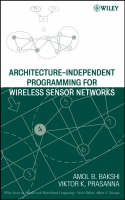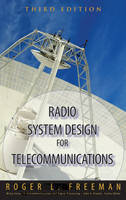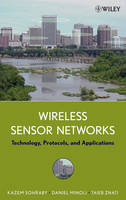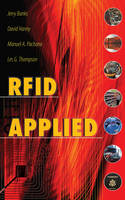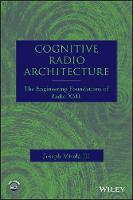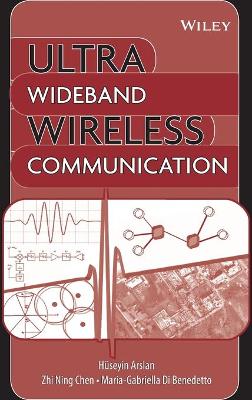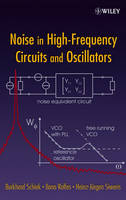History of Wireless
 -15%
portes grátis
-15%
portes grátis
History of Wireless
Salazar-Palma, Magdalena; Sengupta, Dipak L.; Oliner, Arthur A.; Sarkar, T. K.; Mailloux, Robert
John Wiley & Sons Inc
02/2006
680
Dura
Inglês
9780471718147
15 a 20 dias
1220
Chapter 1 Introduction.
1.1 Prologue.
1.2 Development of Magnetism.
1.3 Development of Electricity.
1.4 Development of the Theory of Light.
1.5 Who Was Maxwell?
1.6 What WasAs Maxwell's Electromagnetic Theory?
1.7 Conclusions.
Chapter 2 A Chronology of Developments of Wireless Communication and Supporting Electronics.
2.1 Introduction.
2.2 Acknowledgments.
2.3 Background.
2.4 Some Crucial Events of the Nineteenth Century.
2.5 Some Crucial Events of the Twentieth Century.
2.6 Epilogue.
Chapter 3 Evolution of Electromagnetics in the Nineteenth Century.
3.1 Introduction.
3.2 Continental Electromagnetics.
3.3 British Electromagnetics.
3.4 Conclusion.
Chapter 4 The Genesis of Maxwell's Equations.
4.1 Introduction .
4.2 On Faraday's Lines of Force.
4.3 On Physical Lines of Force.
4.4 A Dynarnical Theory of the Electromagnetic Field .
Chapter 5 Maxwell, Hertz, the Maxwellians and the Early History of Electromagnetic Waves.
5.1 Introduction.
5.2 Speculations of Electromagnetic Propagation Before Maxwell.
5.3 Maxwell's Electromagnetic Theory of Light.
5.4 Acceptance of Maxwell's Theory.
5.5 Hertz and the Maxwellians.
5.6 Conclusion.
Chapter 6 Oliver Heaviside.
6.1 Introduction.
6.2 Heaviside's Life.
6.3 Heaviside's Contributions.
6.4 Conclusions.
6.5 Acknowledgments.
Chapter 7 Wireless before Marconi.
7.1 Introduction.
7.2 Conduction Telegraph.
7.3 Induction Telegraph .
7.4 Electromagnetic Telegraph.
Chapter 8 Nikola Tesla and His Contributions to Radio Development.
8.1 Introduction.
8.2 Invention of the Tesla Coil.
8.3 Radio Controlled Vehicle.
8.4 Colorado Springs Laboratory.
8.5 Marconi and Braun Research.
8.6 Long Island Laboratory.
8.7 Conclusions.
8.8 Acknowledgments.
Chapter 9 An Appreciation of J. C. Bose's Pioneering Work in Millimeter and Microwaves.
9.1 Introduction.
9.2 Historical Perspective.
9.3 A 60 GHz Transmission System.
9.4 Development of the Receiver.
9.5 Demonstration of Propagation.
9.6 Demonstration of the Phenomenon of Refraction.
9.7 Demonstration of the Phenomenon of Polarization.
9.8 Demonstration of the Phenomenon Similar to Photoelectric Effect.
9.9 Measurement of Wavelength.
9.10 Development of the Galena Detector.
9.1 1 Biological Effects of millimeter Waves.
9.12 Conclusion
9.1 3 Epilogue.
9.14 Biographical Sketch. .
Chapter 10 Sir John Ambrose Fleming - His Involvement in the Development of Wireless.
10.1 Introduction.
10.2 The Early Years.
10.3 Research of the University Professor.
10.4 Scientific Advisor to the Marconi Company.
10.5 The Thermionic Valve.
10.6 Later Life.
Chapter 11 Historical German Contributions to Physics and Applications of Electromagnetic Oscillations and Waves.
11.1 Introduction.
1 1.2 Chronology of Historical German Contributions.
11.3 Acknowledgments.
Chapter 12 The Development of Wireless Telegraphy and Telephony, and Pioneering Attempts to Achieve Transatlantic Wireless Communications.
12.1 Introduction.
12.2 A Brief History of the Birth of Wireless.
12.3 Experiments on Sparks and the Generation of Electromagnetic Waves.
12.4 Early Receiving Device.
12.5 Continuous Wave Transmitters.
12.6 Antenna Systems.
12.7 Marconi's First Transatlantic Experiment .
12.8 Marconi's Stations at Glace Bay.
12.9 Fessenden's Brant Rock Station. .
12.10 Transatlantic Experiments in the First Decade of the Twentieth Century.
12.11 On Qualitykeliability of Marconi's Transmission.
12.12 On Qualitykeliability of Fessenden's Transmission.
12.13 Marine Wireless Communications.
12.14 Wireless Telephony Is Born.
12.15 The First Radio Propagation Experiments.
12.16 Fessenden and Marconi, the Men.
12.1 7 Closing Remarks.
12.18 Acknowledgements.
Chapter 13 Wireless Telegraphy in South Africa at the Turn of the Twentieth Century.
13.1 Introduction.
1 3.2 The Cape Colony.
13.3 The South Ahcan Republic.
13.4 The British Experience.
13.5 After the South African War.
13.6 IEEE Milestone in Electrical Engineering.
13.7 Acknowledgments.
Chapter 14 The Antenna Development in Japan: Past and Present.
14.1 Introduction.
14.2 Maxwell, Hertz, and Their Followers in Japan.
14.3 Marconi and the First Japanese Wireless Communication.
14.4 Sea Battle of the Tsushima Straits and the Japanese Radiotelegraph .
14.5 Yagi-Uda Antenna.
14.6 Kinjiro Okabe and his Split-Anode Magnetron.
14.7 Radar in World War II.
14.8 Electrical Engineering Milestones in Japan.
14.9 Conclusion.
Chapter 15 Historical Background and Development of Soviet Quasioptics at Near-mm and Sub-mm Wavelengths.
15.1 Introduction.
15.2 Quasioptics in the Broad and Narrow Sense.
15.3 Pioneering Research into "Hertz Optics" (1 888-1 900) and Lebedev's Contribution.
15.4 Early Success: Free Space Gaussin-Beam Quasioptical Technologies.
15.5 Alternative: Metallic Oversized Waveguides (since 1953) - Quasioptics in Disguise.
15.6 Compromise No 1 : Discrete Beam Waveguides and East-West Competition (since 1961).
15.7 Compromise No. 2: Continuous Beam Waveguides as a Widely Used USSR Technology (since 1963).
15.8 Brief Survey of Modeling Methods and Tools Used in Quasioptics.
15.9 New Frontiers of the XXI Century: Optics Goes Quasioptical.
15.10 Acknowledgments.
Chapter 16 The Evolution of Electromagnetic Waveguides: From Hollow Metallic Guides to Microwave Integrated Circuits.
16.1 Hollow Metallic Waveguides.
Chapter 17 A History of Phased Array Antennas.
17.1 Introduction.
17.2 The Early History.
17.3 Electromechanical and Frequency Scanning.
17.4 The Technology of Array Control.
17.5 Phase Array Analysis and Synthesis.
17.6 The Future.
17.7 Author's Comments.
17.8 Acknowledgments.
References.
Index.
Chapter 1 Introduction.
1.1 Prologue.
1.2 Development of Magnetism.
1.3 Development of Electricity.
1.4 Development of the Theory of Light.
1.5 Who Was Maxwell?
1.6 What WasAs Maxwell's Electromagnetic Theory?
1.7 Conclusions.
Chapter 2 A Chronology of Developments of Wireless Communication and Supporting Electronics.
2.1 Introduction.
2.2 Acknowledgments.
2.3 Background.
2.4 Some Crucial Events of the Nineteenth Century.
2.5 Some Crucial Events of the Twentieth Century.
2.6 Epilogue.
Chapter 3 Evolution of Electromagnetics in the Nineteenth Century.
3.1 Introduction.
3.2 Continental Electromagnetics.
3.3 British Electromagnetics.
3.4 Conclusion.
Chapter 4 The Genesis of Maxwell's Equations.
4.1 Introduction .
4.2 On Faraday's Lines of Force.
4.3 On Physical Lines of Force.
4.4 A Dynarnical Theory of the Electromagnetic Field .
Chapter 5 Maxwell, Hertz, the Maxwellians and the Early History of Electromagnetic Waves.
5.1 Introduction.
5.2 Speculations of Electromagnetic Propagation Before Maxwell.
5.3 Maxwell's Electromagnetic Theory of Light.
5.4 Acceptance of Maxwell's Theory.
5.5 Hertz and the Maxwellians.
5.6 Conclusion.
Chapter 6 Oliver Heaviside.
6.1 Introduction.
6.2 Heaviside's Life.
6.3 Heaviside's Contributions.
6.4 Conclusions.
6.5 Acknowledgments.
Chapter 7 Wireless before Marconi.
7.1 Introduction.
7.2 Conduction Telegraph.
7.3 Induction Telegraph .
7.4 Electromagnetic Telegraph.
Chapter 8 Nikola Tesla and His Contributions to Radio Development.
8.1 Introduction.
8.2 Invention of the Tesla Coil.
8.3 Radio Controlled Vehicle.
8.4 Colorado Springs Laboratory.
8.5 Marconi and Braun Research.
8.6 Long Island Laboratory.
8.7 Conclusions.
8.8 Acknowledgments.
Chapter 9 An Appreciation of J. C. Bose's Pioneering Work in Millimeter and Microwaves.
9.1 Introduction.
9.2 Historical Perspective.
9.3 A 60 GHz Transmission System.
9.4 Development of the Receiver.
9.5 Demonstration of Propagation.
9.6 Demonstration of the Phenomenon of Refraction.
9.7 Demonstration of the Phenomenon of Polarization.
9.8 Demonstration of the Phenomenon Similar to Photoelectric Effect.
9.9 Measurement of Wavelength.
9.10 Development of the Galena Detector.
9.1 1 Biological Effects of millimeter Waves.
9.12 Conclusion
9.1 3 Epilogue.
9.14 Biographical Sketch. .
Chapter 10 Sir John Ambrose Fleming - His Involvement in the Development of Wireless.
10.1 Introduction.
10.2 The Early Years.
10.3 Research of the University Professor.
10.4 Scientific Advisor to the Marconi Company.
10.5 The Thermionic Valve.
10.6 Later Life.
Chapter 11 Historical German Contributions to Physics and Applications of Electromagnetic Oscillations and Waves.
11.1 Introduction.
1 1.2 Chronology of Historical German Contributions.
11.3 Acknowledgments.
Chapter 12 The Development of Wireless Telegraphy and Telephony, and Pioneering Attempts to Achieve Transatlantic Wireless Communications.
12.1 Introduction.
12.2 A Brief History of the Birth of Wireless.
12.3 Experiments on Sparks and the Generation of Electromagnetic Waves.
12.4 Early Receiving Device.
12.5 Continuous Wave Transmitters.
12.6 Antenna Systems.
12.7 Marconi's First Transatlantic Experiment .
12.8 Marconi's Stations at Glace Bay.
12.9 Fessenden's Brant Rock Station. .
12.10 Transatlantic Experiments in the First Decade of the Twentieth Century.
12.11 On Qualitykeliability of Marconi's Transmission.
12.12 On Qualitykeliability of Fessenden's Transmission.
12.13 Marine Wireless Communications.
12.14 Wireless Telephony Is Born.
12.15 The First Radio Propagation Experiments.
12.16 Fessenden and Marconi, the Men.
12.1 7 Closing Remarks.
12.18 Acknowledgements.
Chapter 13 Wireless Telegraphy in South Africa at the Turn of the Twentieth Century.
13.1 Introduction.
1 3.2 The Cape Colony.
13.3 The South Ahcan Republic.
13.4 The British Experience.
13.5 After the South African War.
13.6 IEEE Milestone in Electrical Engineering.
13.7 Acknowledgments.
Chapter 14 The Antenna Development in Japan: Past and Present.
14.1 Introduction.
14.2 Maxwell, Hertz, and Their Followers in Japan.
14.3 Marconi and the First Japanese Wireless Communication.
14.4 Sea Battle of the Tsushima Straits and the Japanese Radiotelegraph .
14.5 Yagi-Uda Antenna.
14.6 Kinjiro Okabe and his Split-Anode Magnetron.
14.7 Radar in World War II.
14.8 Electrical Engineering Milestones in Japan.
14.9 Conclusion.
Chapter 15 Historical Background and Development of Soviet Quasioptics at Near-mm and Sub-mm Wavelengths.
15.1 Introduction.
15.2 Quasioptics in the Broad and Narrow Sense.
15.3 Pioneering Research into "Hertz Optics" (1 888-1 900) and Lebedev's Contribution.
15.4 Early Success: Free Space Gaussin-Beam Quasioptical Technologies.
15.5 Alternative: Metallic Oversized Waveguides (since 1953) - Quasioptics in Disguise.
15.6 Compromise No 1 : Discrete Beam Waveguides and East-West Competition (since 1961).
15.7 Compromise No. 2: Continuous Beam Waveguides as a Widely Used USSR Technology (since 1963).
15.8 Brief Survey of Modeling Methods and Tools Used in Quasioptics.
15.9 New Frontiers of the XXI Century: Optics Goes Quasioptical.
15.10 Acknowledgments.
Chapter 16 The Evolution of Electromagnetic Waveguides: From Hollow Metallic Guides to Microwave Integrated Circuits.
16.1 Hollow Metallic Waveguides.
Chapter 17 A History of Phased Array Antennas.
17.1 Introduction.
17.2 The Early History.
17.3 Electromechanical and Frequency Scanning.
17.4 The Technology of Array Control.
17.5 Phase Array Analysis and Synthesis.
17.6 The Future.
17.7 Author's Comments.
17.8 Acknowledgments.
References.
Index.



